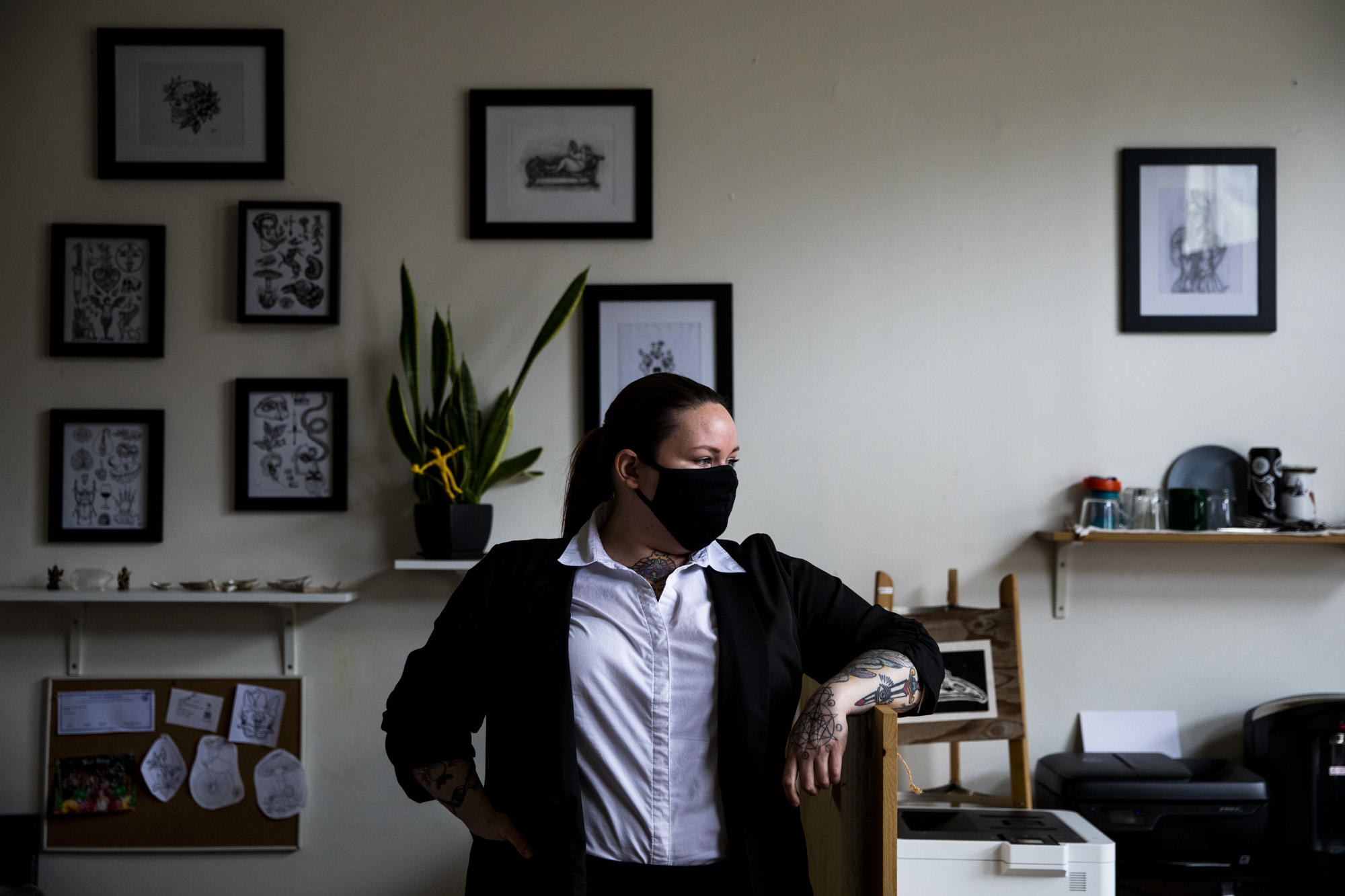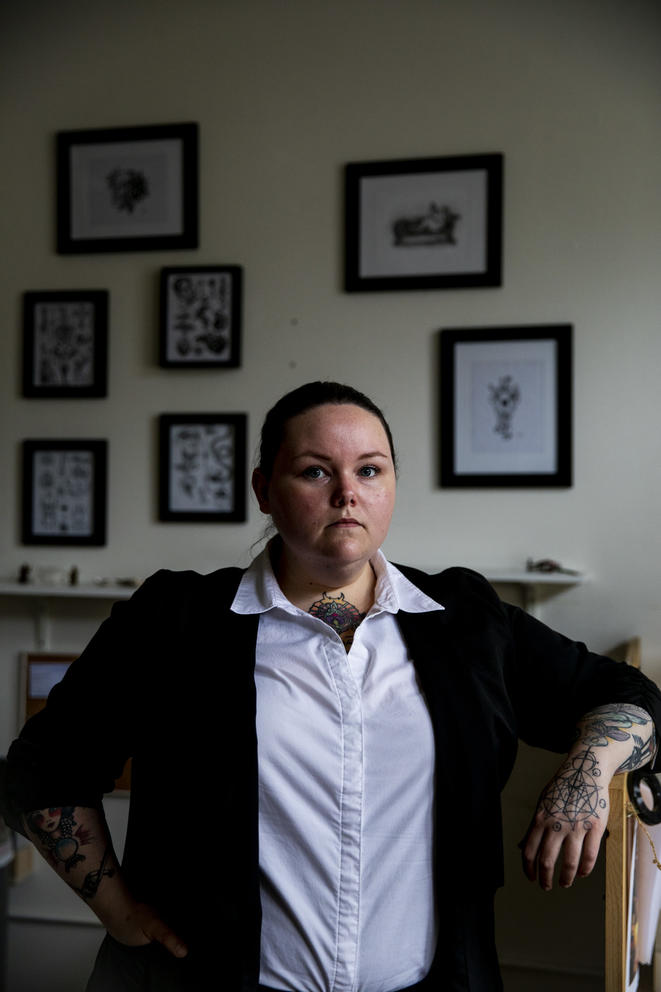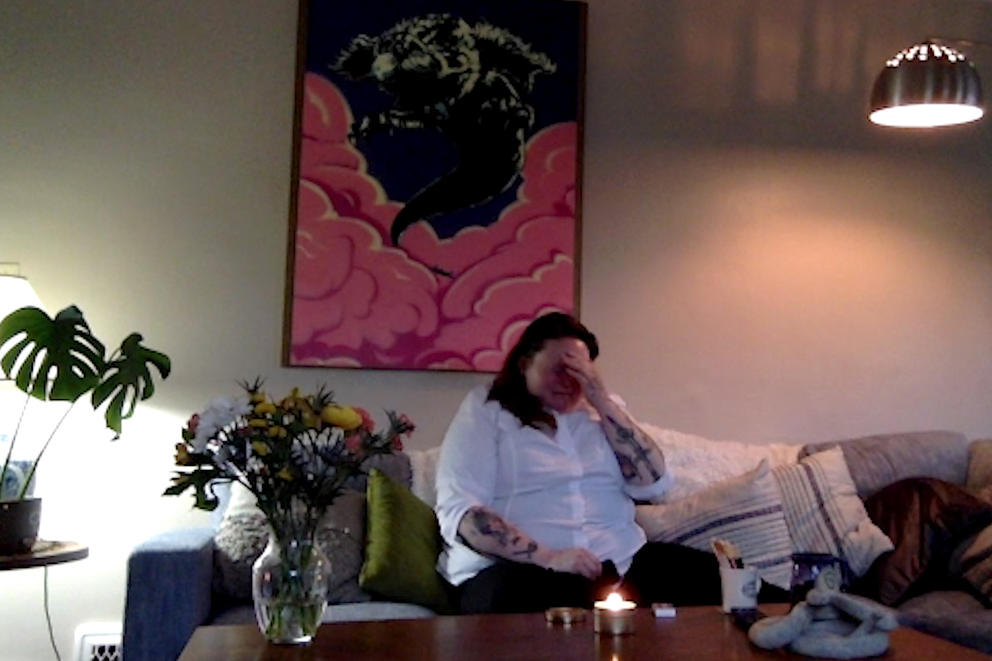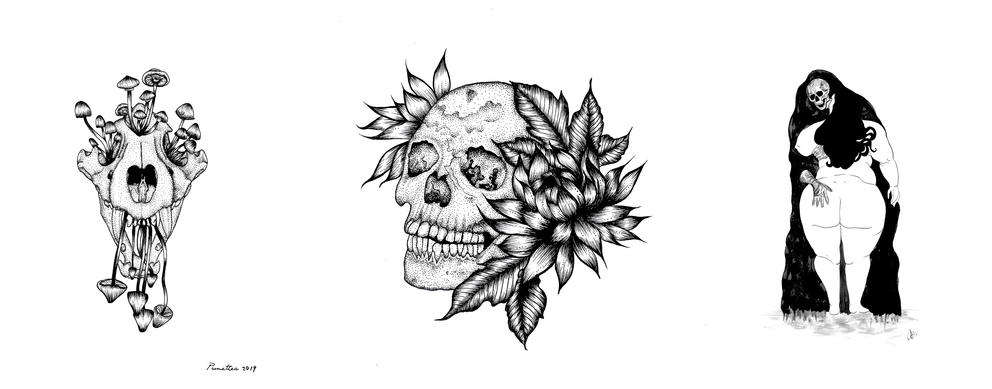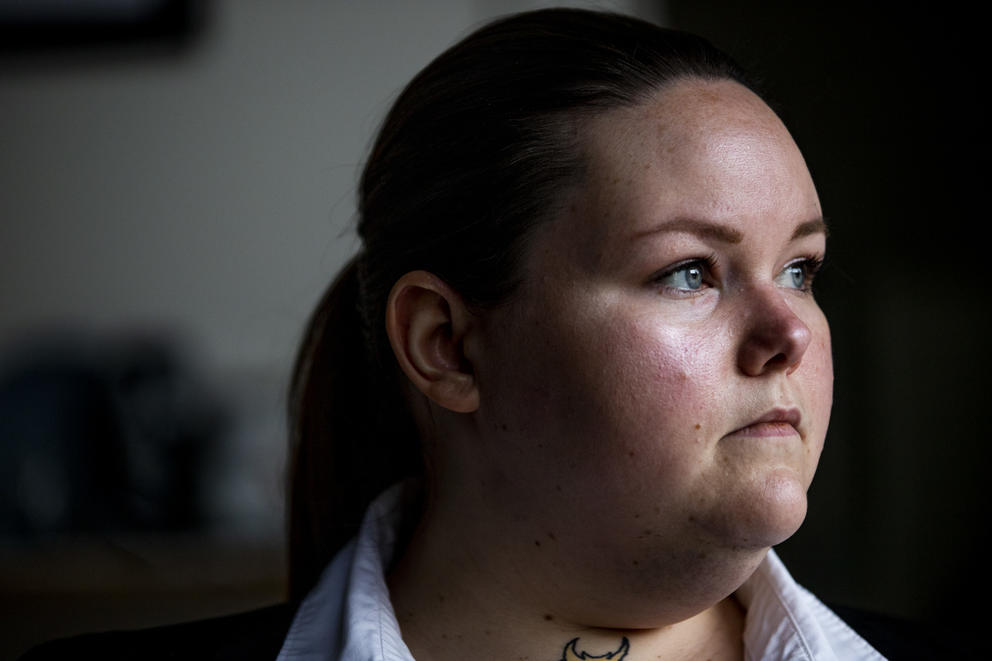“I’m as ready as I’ll ever be,” Henry responded, and opened the car door. She walked up to the house to do something she had never done before: collect a deceased body.
Just a few weeks earlier, she was still working her dream job: covering people’s skin with Pacific Northwest flora, starry skies, snakes, skulls and skeletons as an independent tattoo artist at Lilith, a queer tattoo and art studio in Fremont. When the shop closed in March in response to Gov. Jay Inslee’s “Stay Home, Stay Healthy” order, her income evaporated. She felt the ground shift beneath her feet.
Listen to Jessica Henry tell her story on Crosscut's This Changes Everything podcast.
“There’s some sort of identity crisis when you look at what you do to sustain yourself, and say: ‘Oh, that’s not essential,’” Henry says. “‘What means most to me in the entire world is not essential.’”
On a phone call with a friend who did have an essential job, Henry blurted out: “What can I do to help?” She wanted to be of service during the pandemic, to do something. She was also anxious about the absence of a regular paycheck. The friend said she would check in with her boss — who managed a mortuary company.
Masked bodies
Each industry develops its own lingo, and so-called death care is no exception. A body is not a corpse, but a “decedent.” “A residential” is code for someone who has died at home, as opposed to a morgue or hospital. And then there’s the “removal technician,” the person entering homes, hospitals and nursing homes to retrieve the dead and transporting them to the mortuary (also called a “care center”).
Henry is now a removal technician. She drives all over the Seattle metropolitan area to meet the dead where they passed away mere hours earlier, and then drives them to the death care center. (With the dark humor required for this kind of work, Henry describes the destination as “death Costco” because it “has everything,” including a warehouse full of caskets.)
Her first “removal” took place at a midcentury modern house in North Seattle surrounded by a lush garden and a few slippery outdoor stairs still glistening from the rain. Waiting for her inside were the wife and daughters of the man who had just passed and was lying in the bedroom.
“I was terrified,” Henry says, “but the second we stepped in the house and met the family … something else just kicked in for me. I was there with them, and I remember feeling a lot of their grief.”
That was mid-April. In Washington, more than 500 people had already died of COVID-19-related causes — and the number was rising. The state hadn’t seen the same dramatic spike in deaths in late March and April as New York, where the National Guard and Army had been called in to help with the retrieval of bodies, as morgues overflowed. But in Washington, as elsewhere, the industry had already been profoundly reshaped.
Henry had hurled herself into a new reality that includes Zoom funerals and socially distant wakes, where entering a hospital morgue or a private home is potentially hazardous. In this new normal, the dead are divided into two groups: the COVID-positive and the rest. Roughly one in four people Henry picks up, she says, are COVID-positive.
“Working on the backend of the front lines has been sobering,” Henry says. “It’s made me recognize my own mortality and the absolute seriousness of the situation.”
On the job, there’s no way of escaping the everyday realities of the coronavirus. Henry has to wear a mask at all times. Sometimes she has to put masks on the bodies, too, because they could still exhale particles if there’s air trapped in their lungs, air that Henry breathes in the transport van.
At times, when she’s driving a masked, COVID-positive decedent to the morgue, anxiety creeps up; she’s putting herself at risk. One of her colleagues quit because of the added stress and pressures of the job under the coronavirus.
Henry experiences the weight of the pandemic, too. “It feels heavy,” she says. But “I’m grateful I’m not removed from it. I’m grateful that I get to experience what is happening at its most base level, its most real level.”
Sometimes the heaviness doesn’t have to mean COVID-positive bodies. Sometimes it’s navigating a hospital, which has become stressful, Henry says. From co-workers, she gathers “it used to be a pretty quick pickup if you had to go get someone from a [hospital] morgue. But now, rightfully so, they’re screening everybody. There’s heightened levels of security. I’ve heard stories from security guards of families trying to sneak in the exits to visit their loved one who’s dying because they are not allowed to go in.”
Jessica Henry cries on her couch after coming home from work on May 30. She describes this work as crucial to keeping society functioning. After work she often lights a candle and takes time to “get back in my own body and out of other people's grief.” (Photo taken via Zoom videoconferencing by Dorothy Edwards/Crosscut)
Stamina and grief
The coronavirus has not just ravaged bodies and economies — it’s also made grief lonelier. The absence of closeness and touch is something many death care workers find themselves grappling with as well.
Henry is often one of the first people a family encounters after the death of their loved one, sometimes after the first responders or the hospice worker leaves. She often finds herself being the one who first consoles the family.
Prior to COVID-19, Henry says, she would have been allowed to give a hug, pat someone gently on the back, shake or hold a hand. That’s not possible anymore. Plus: how do you convey compassion when half of your face is covered by a mask? Or gently explain the removal process to a hard-of-hearing widow grieving the loss of her lifelong partner?
“It’s not easy. You’re seeing someone on the worst day of their life, every single day,” Henry says. “It’s a really delicate process. It’s something I didn’t really know I could do until I did it the first time. I realized, maybe I can hold space for people like this. Maybe it’s not that different from tattooing. I’m in these people’s lives for a really short time, but I’m able to support them through something really difficult.”
Watching Six Feet Under
Tattooing and death care work require a similar skill set, Henry says. You need to be able to be there for a person in pain, “whether it’s experiencing the loss of a loved one or choosing to commemorate something that is really meaningful to them.”
Plus, the work of both can be physical and requires stamina. To make it as a woman in a sexist industry (tattooing). To move eight bodies in a day (lifting a lifeless body onto a cot all by yourself requires “brute strength and grace,” as Henry puts it). To execute the details of an elaborate tattoo, hunched over another body for four hours.
And, frankly, you just have to have the stomach for it. “A lot of people hate needles,” Henry says. “They can’t see blood. They can’t have that visceral, kind of penetrative experience. People have a similar reaction to [dead] bodies. Neither of those things are something that we’re really conditioned to be able to deal with on a day-to-day basis.”
But Henry has always had a strong stomach for things others don’t find palatable. “Death has never been really that scary to me,” she says.
Perhaps that’s because it came crashing into her life at such an early age. She was just 8 years old, playing with a friend outside her house, when he was run over by a dump truck. Henry still remembers the tire tracks on his chest, his face turning blue. She was the one who called 911. “My first experience with death was one of my peers,” Henry says. “It was hard and harrowing, but it also made me very curious.”
Growing up Mormon in northern Utah, she had always been taught that bodies would be resurrected. That death was not the end. She started to doubt that.
Later in life, Henry left Mormonism. But the specter of death never quite let her go. In middle school, she wanted nothing more than to be an artist, but also considered attending mortuary school (she blames watching many an episode of Six Feet Under, a television series about a family’s funeral home business). She ended up majoring in philosophy at the University of California, Irvine. The first tattoo she ever got? The Latin aphorism “Ars longa, vita brevis,” roughly: Life is short, art eternal.
“It’s the idea that whatever mark you make on this world is going to outlast you,” she says.
“There’s this whole thing where people are like: ‘tattoos are so permanent.’ Well, you can’t really say that once you’ve seen someone in a body bag with the most gorgeous full sleeve [tattoo] you’ve ever seen,” she says. “Everyone talks about how permanent tattoos are. They’re not, because life is impermanent.”
In some ways, death and tattoos are inextricably linked. Tattoos stretch (and die) along with their human canvas. Tattoos often memorialize milestones in life, a rite of passage, or death — of a loved one, or perhaps a former self. In many cultures, tattoos are seen as a form of identification in the afterlife. Consider the common motifs: the Santa Muerte, the grim reaper, the skull, the tombstone.
Or a skeleton engulfed in flames. On one of her first days as a removal technician, during a tour through the death care center, a worker had fired up the cremation ovens and slid open a giant metal door to check the status of the cremation in progress. Just one glance revealed an image Henry will never forget: a human skeleton literally engulfed in flames. “It’s one of the most incredible and terrifying things I’ve ever seen,” she says. She’s currently capturing the image on paper, perhaps for a later tattoo.
After a long day of being on call, or a last-minute midnight removal, drawing (along with journaling and teleconferencing with her therapist) has helped her cope, she says. “It’s helping me not just get through the daily grind of this job, but confront my own mortality on a very deep level, and it’s beautiful.”
“It’s a part of life that is so undeniable and present, but so many people spend their entire lives pretending like we don’t die, or ignoring it,” Henry says. “To be confronted with it adds a lot more meaning to my day to day.”
Once Lilith reopens, Henry plans to go back to tattooing part-time, so she can continue being a removal technician. She can’t let go of death care work. “From an emotional and a physical standpoint, it's pretty grueling,” she says, but ironically, the job has made her feel more alive than ever. “Seeing the way families react to losing their people has been an experience that has changed me,” Henry says. “It’s made me a lot more grateful for the connections that I have, and the people who look out for me ... and this life that we get to lead. Even quarantine life is a gift.”
Get the latest in local arts and culture
This weekly newsletter brings arts news and cultural events straight to your inbox.

